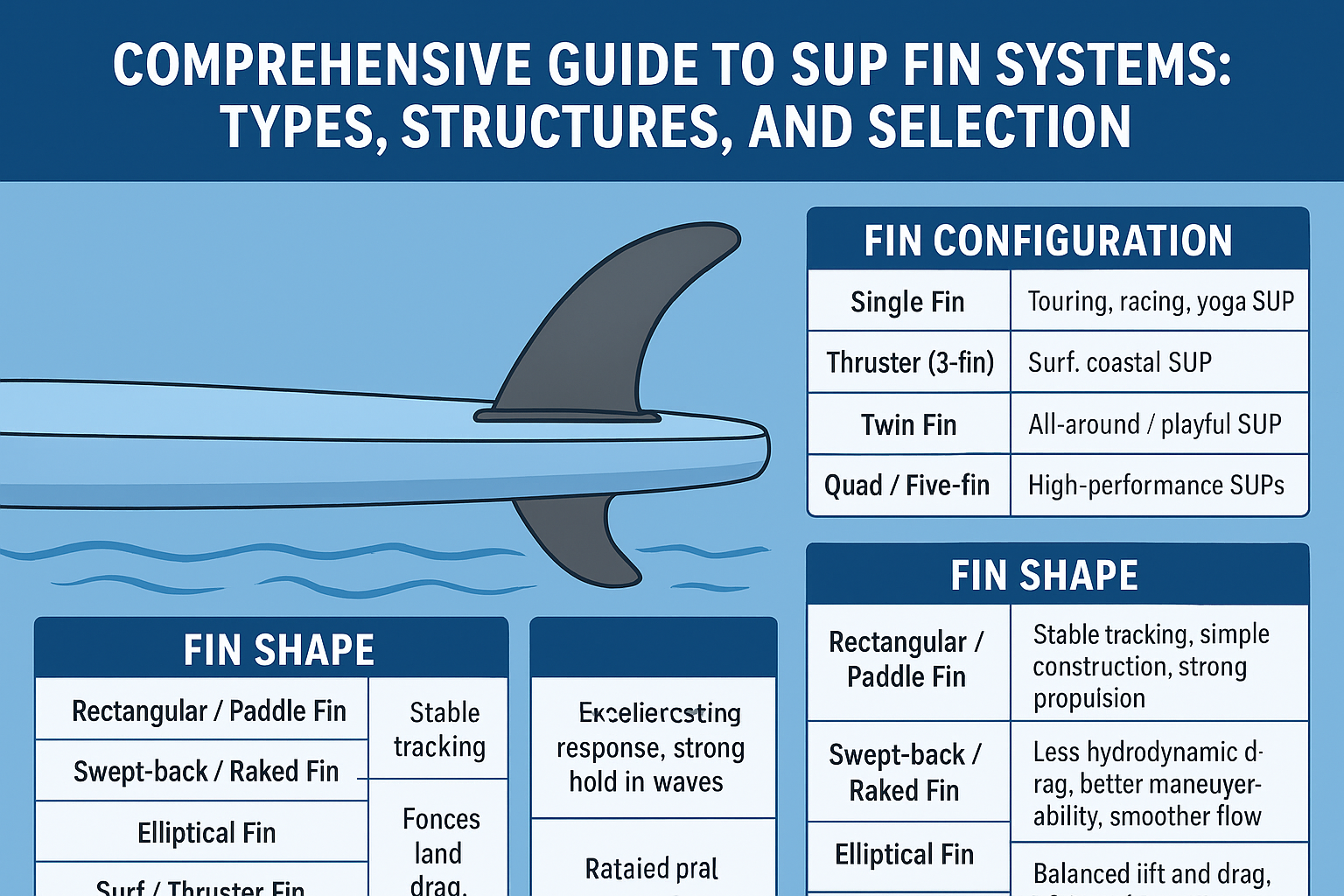
SUP Fin System Technical Guide
This article provides a comprehensive overview of stand-up paddle board (SUP) fin systems, including installation types, configurations, materials, and hydrodynamic shapes. Understanding these systems helps you select the right fin for touring, racing, surfing, and recreational paddling.
Ⅰ. Classification by Installation Type
1. Fixed (Glass-On / Molded-In) Fins
Description: The fin is permanently attached to the board and cannot be removed.
Advantages: Lightweight, firm, durable, and requires no assembly.
Disadvantages: Non-removable; difficult to replace or repair; inconvenient for transportation.
Applications: Common on entry-level touring boards, low-cost models, and surf SUPs.
2. Removable Fin Systems
Removable fins dominate modern SUP design, offering flexibility and interchangeability. The most popular systems include:
| Fin System | Features | Advantages | Disadvantages | Common Applications |
|---|---|---|---|---|
| US Box | Universal screw-in slot design compatible with many fins. | Adjustable fin position; stable tracking; widely standardized. | Requires tools (bolt or screw); slower installation. | Touring, racing SUPs. |
| SmartLock / Quick-Lock | Tool-free fin mount with a locking latch. | Fast installation; stable lock; clean structure. | Limited compatibility; proprietary design. | Inflatable SUPs, travel boards. |
| FCS / Futures Plug | Dual or triple plug systems for surf-style fins. | Multiple fin setups (1+2 thruster); good control. | Complex structure; limited iSUP compatibility. | Surf SUPs, coastal boards. |
Ⅱ. Classification by Fin Configuration
| Configuration | Structure | Advantages | Disadvantages | Applications |
|---|---|---|---|---|
| Single Fin | One large center fin. | Stable tracking, efficient straight-line glide. | Reduced maneuverability. | Touring, racing, yoga SUPs. |
| Twin Fin | Two side fins only. | Agile, flexible movement, less drag. | Lower tracking ability. | Playful, lightweight boards. |
| Thruster (3 Fin) | 1 center + 2 side fins. | Balanced stability and control; easy turning. | More resistance than single fin. | Surf and all-around SUPs. |
| Quad / Five-Fin | Four or five fins. | Maximum propulsion and control. | Higher drag, complex setup. | Professional surf SUPs. |
Ⅲ. Classification by Material
| Material | Characteristics | Advantages | Disadvantages | Applications |
|---|---|---|---|---|
| Plastic (Thermoplastic) | Soft and flexible. | Safe, low-cost, impact-resistant. | Low stiffness, less efficient. | Inflatable SUPs, beginners. |
| Fiberglass | Moderate rigidity. | Good performance-to-cost ratio. | Can chip or crack under impact. | All-around boards. |
| Carbon Fiber | Ultra-light, high stiffness. | Excellent speed, stability, and power transfer. | Expensive. | Professional racing SUPs. |
| Composite (Plastic + Fiber) | Combination of materials. | Balanced durability and performance. | Medium weight, moderate cost. | Mid-range SUPs. |
Ⅳ. Classification by Fin Shape
| Shape | Description | Advantages | Disadvantages | Application |
|---|---|---|---|---|
| Rectangular (Paddle) | Flat, wide profile for strong propulsion. | Stable, powerful glide. | Higher drag, slower turning. | Touring SUPs. |
| Swept-Back (Raked) | Fin curves backward for smoother flow. | Better maneuverability, reduced resistance. | More expensive to produce. | All-around and racing SUPs. |
| Elliptical | Rounded profile optimized for long-distance glide. | Efficient lift-drag balance. | High manufacturing cost. | High-end touring boards. |
| Surf / Thruster | Short, raked design for wave control. | Responsive turning, strong hold. | High drag in flat water. | Surf SUPs. |
Ⅴ. Classification by Hydrodynamic Section
| Section Type | Characteristics | Advantages | Applications |
|---|---|---|---|
| Symmetrical | Equal curvature on both sides. | Stable handling, predictable behavior. | Surf fins, control-oriented designs. |
| Cambered | Lift-generating curvature. | Higher speed and efficiency. | Touring and racing SUPs. |
| Thin Profile | Sharp edge, low resistance. | Fast glide, minimal drag. | Racing boards. |
| Thick Base (Root) | Reinforced structure for stiffness. | Durable, strong load-bearing. | Fishing and heavy-duty SUPs. |
Ⅵ. Recommended Fin Types by Application
| Usage Scenario | Recommended Fin | Key Features |
|---|---|---|
| Long-Distance Touring | Raked fin (23–28 cm) | Strong tracking, cambered airfoil, carbon or composite material. |
| Coastal Surfing | Thruster setup (1 center + 2 sides) | Better control and quick response in waves. |
| Fishing / Heavy Load | Thick-base fin (25 cm+) | Stable and strong under weight. |
| Shallow or Rocky Waters | Short, flexible plastic fin | Impact-safe, prevents damage. |
Summary
Choosing the right SUP fin involves balancing stability, control, and hydrodynamics. The US Box remains the most universal system for touring and all-around boards, while SmartLock offers the fastest tool-free setup for inflatable SUPs. Fin material and shape also significantly affect performance — carbon fiber provides efficiency for professionals, whereas composite and plastic options are perfect for casual paddlers.
